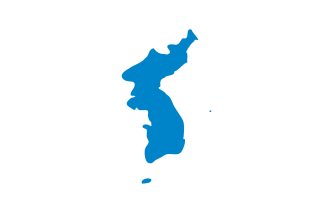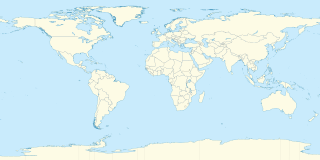
Korea is a region in East Asia. Since 1945 it has been divided into two sovereign states: North Korea and South Korea. Korea consists of the "mainland Korean Peninsula", Jeju Island, and several minor islands near the peninsula. It is bordered by China to the northwest and Russia to the northeast. It is separated from Japan to the east by the Korea Strait and the Sea of Japan.

Korean is an East Asian language spoken by about 77 million people. It is the official and national language of both Koreas: North Korea and South Korea, with different standardized official forms used in each country. It is a recognised minority language in the Yanbian Korean Autonomous Prefecture and Changbai Korean Autonomous County of Jilin Province, China. It is also spoken in parts of Sakhalin, Russia and Central Asia.

The Korean War was a war between North Korea and South Korea. The war began on 25 June 1950 when North Korea invaded South Korea following clashes along the border and insurrections in the south. The war ended unofficially on 27 July 1953 in an armistice.

North Korea, officially the Democratic People's Republic of Korea, is a country in East Asia constituting the northern part of the Korean Peninsula. The country is bordered to the north by China and by Russia along the Amnok and Tumen rivers, and to the south by South Korea, with the heavily fortified Korean Demilitarized Zone (DMZ) separating the two. North Korea, like its southern counterpart, claims to be the legitimate government of the entire peninsula and adjacent islands. Pyongyang is the country's capital and largest city.

South Korea, officially the Republic of Korea, is a country in East Asia, constituting the southern part of the Korean Peninsula, and sharing a land border with North Korea. 25 million people, around half of the country's population of more than 51 million people, live in the Seoul Capital Area, the fifth-largest metropolitan area in the world.

South Korea is located in East Asia, on the southern half of the Korean Peninsula located out from the far east of the Asian landmass. The only country with a land border to South Korea is North Korea, lying to the north with 238 kilometres (148 mi) of the border running along the Korean Demilitarized Zone. South Korea is mostly surrounded by water and has 2,413 kilometres (1,499 mi) of coast line along three seas; to the west is the Yellow Sea, to the south is the East China Sea, and to the east is the Sea of Japan. Geographically, South Korea's landmass is approximately 100,032 square kilometres (38,623 sq mi). 290 square kilometres (110 sq mi) of South Korea are occupied by water. The approximate coordinates are 37° North, 128° East.

The Lower Paleolithic era in the Korean Peninsula and Manchuria began roughly half a million years ago. The earliest known Korean pottery dates to around 8000 BC, and the Neolithic period began after 6000 BC, followed by the Bronze Age by 2000 BC, and the Iron Age around 700 BC.

The Yellow Sea is a marginal sea of the Western Pacific Ocean located between mainland China and the Korean Peninsula, and can be considered the northwestern part of the East China Sea. It is one of four seas named after common colour terms, and its name is descriptive of the phenomenon whereby fine sand grains from the Gobi Desert sand storms, that descend annually from the north, turn the surface of its waters a golden yellow.

The Russian Far East is a region in North Asia which includes the Far Eastern Federal District, the easternmost territory of Russia, between Lake Baikal in Eastern Siberia and the Pacific Ocean.

South Gyeongsang Province is a province in the southeast of South Korea. The provincial capital is at Changwon. It is adjacent to the major metropolitan center and port of Busan. There is UNESCO World Heritage Site Haeinsa, a Buddhist temple that houses the Tripitaka Koreana and attracts many tourists. Automobile and petrochemical factories are largely concentrated along the southern part of the province, extending from Ulsan through Busan, Changwon, and Jinju.

The Korean Demilitarized Zone is a strip of land running across the Korean Peninsula. It is established by the provisions of the Korean Armistice Agreement to serve as a buffer zone between North Korea and South Korea. The demilitarized zone (DMZ) is a border barrier that divides the Korean Peninsula roughly in half. It was created by agreement between North Korea, China and the United Nations Command in 1953. The DMZ is 250 kilometres long, and about 4 kilometres wide.

Koreans are an East Asian ethnic group native to Korea and southwestern Manchuria.

Japonic or Japanese–Ryukyuan is a language family comprising Japanese, spoken in the main islands of Japan, and the Ryukyuan languages, spoken in the Ryukyu Islands. The family is universally accepted by linguists, and significant progress has been made in reconstructing the proto-language. The reconstruction implies a split between all dialects of Japanese and all Ryukyuan varieties, probably before the 7th century. The Hachijō language, spoken on the Izu Islands, is also included, but its position within the family is unclear.

Samhan, or Three Han, is the collective name of the Byeonhan, Jinhan, and Mahan confederacies that emerged in the first century BC during the Proto–Three Kingdoms of Korea, or Samhan, period. Located in the central and southern regions of the Korean Peninsula, the Samhan confederacies eventually merged and developed into the Baekje, Gaya, and Silla kingdoms. The name "Samhan" also refers to the Three Kingdoms of Korea.

Korea comprises the Korean Peninsula and 3,960 nearby islands. The peninsula is located in Northeast Asia, between China and Japan. To the northwest, the Amnok River separates Korea from China and to the northeast, the Duman River separates Korea from China and Russia. The Yellow Sea lies to the west, the East China Sea and Korea Strait to the south, and the Sea of Japan to the east. Notable islands include Jeju Island (Jejudo), Ulleung Island (Ulleungdo), and the Liancourt Rocks.

Seoul, officially the Seoul Special City, is the capital and largest metropolis of South Korea. Seoul has a population of 9.7 million people, and forms the heart of the Seoul Capital Area with the surrounding Incheon metropolis and Gyeonggi province. Seoul was the world's 4th largest metropolitan economy in 2014 after Tokyo, New York City and Los Angeles. In 2017, the cost of living in Seoul was ranked the 6th highest globally.

The 38th parallel north is a circle of latitude that is 38 degrees north of the Earth's equatorial plane. It crosses Europe, the Mediterranean Sea, Asia, the Pacific Ocean, North America, and the Atlantic Ocean. The 38th parallel north formed the border between North and South Korea prior to the Korean War.

KBO Futures League or Korea Baseball Futures League is South Korea's second level of baseball, below the KBO League. It serves as a farm league with the purpose to develop professional players on-demand to play in the KBO League. The league consists of two divisions — the Southern League and the Northern League. These leagues are governed by the Korea Baseball Organization (KBO). The league plays an 80-game season.

The Consulate General of South Korea for Southern India is one of the missions of South Korea in India focusing on Korean interests in the region. It is located in Chennai and its jurisdiction includes the states of Tamil Nadu, Karnataka, Kerala and the union territory of Puducherry. The other South Korean missions in the India is the Embassy of the Republic of Korea at New Delhi and the Consulate General of the Republic of Korea in Mumbai, in addition to an honorary consulate office in Kolkata. The current consul general of the Chennai Consulate is Kwon Young Seup. He was preceded by Kim Hyung Tae, the second consul general of the Chennai Consulate.



















